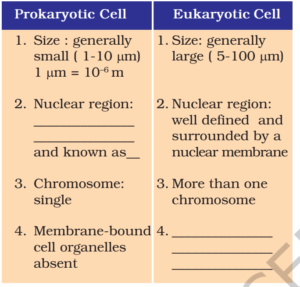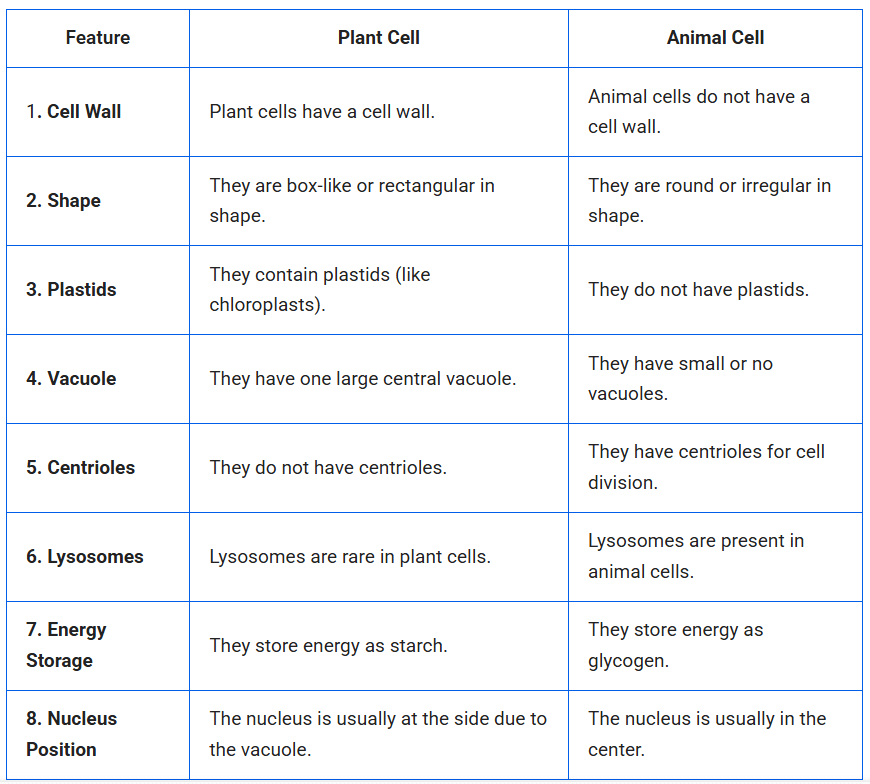NCERT Solutions for Class 9 Science Chapter 5 – The Fundamental Unit of Life
Are you a Class 9 student looking for Chapter 5 Questions & Answers – The Fundamental Unit of Life from Class 9 Science? In this article, we provide complete NCERT solutions for Class 9 Science Chapter 5-The Fundamental Unit of Life, explained in simple language. These answers are based on the latest NCERT books and are perfect for your Board exams. Whether it’s short answers, long answers, this guide will help you score better by strengthening your concepts of cells, cell organelles, and their functions. For a better understanding of this chapter, you should also see Class 9 Chapter 5 The Fundamental Unit of Life – Summary & Revision Notes Class 9 Science Chapter 5–Summary & Revision Notes- The Fundamental Unit of Life |
NCERT Textbook for Class 9 Science – Page 59
1. Who discovered cells, and how?
Answer: Robert Hooke discovered cells in 1665 while examining a thin slice of cork through a self-designed microscope. He observed that the cork resembled the structure of a honeycomb, consisting of many tiny compartments or “boxes.” He named these boxes “cells”, which means “a little room” in Latin.
2. Why the cell is called the structural and Junctional unit of life?
Answer:
Cells build the body of all living things, like bricks in a house. Cells group together to form tissues, organs, and systems, creating the organism’s structure. So, we can call the cell the structural unit of life.
Cells perform all the basic life processes like digestion, growth, and reproduction. Every living being starts its life as a single cell, and that cell carries out all life activities, just like the whole organism. So, we can also call it the functional unit of life.
Class 9 Science NCERT Textbook – Page 61
1. How do substances like C02 and water move in and out of the cell? Discuss.
Answer: Substances like carbon dioxide (CO₂) and water move in and out of the cell through the plasma membrane.
CO₂ moves by diffusion from a place of higher concentration to lower concentration. When CO₂ builds up inside the cell during respiration, it moves out to the external environment. Similarly, if the CO₂ concentration is higher outside, it can enter the cell.
Water moves by osmosis. The plasma membrane allows water to pass through from a region of higher water concentration to lower water concentration. For example, in a hypotonic solution, water enters the cell, causing it to swell. In a hypertonic solution, water leaves the cell, causing it to shrink.
2. Why is the plasma membrane called a selectively permeable membrane?
Answer:
The plasma membrane is called a selectively permeable membrane because it allows only certain substances to pass in and out of the cell while blocking others. Not all molecules are free to diffuse.
Class 9 Science NCERT Textbook – Page 63
1. Fill in the gaps in the following table illustrating differences between prokaryotic and eukaryotic cells.

Answer:
| Prokaryotic Cell | Eukaryotic Cell |
|---|---|
| 1. Size:Generally small (1–10 µm)1 µm = 10–6 m | 1. Size:Generally large (5–100 µm) |
| 2. Nuclear region:The Nuclear region is not well defined, not surrounded by a nuclear membrane, and known as the nucleoid. | 2. Nuclear region:well-defined and surrounded by a nuclear membrane. |
| 3. Chromosome: single | 3. More than one chromosome |
| 4. Membrane-bound cell organelles absent | 4. Membrane-bound cell organelles present (e.g., mitochondria, ER, Golgi bodies) |
NCERT Textbook for Class 9 Science – Page 65
1. Can you name the two organelles we have studied that contain their own genetic material?
Answer:
Yes! The two organelles that contain their own genetic material (DNA) are:
Mitochondria
Plastids (Chloroplasts)
2. If the organisation of a cell is destroyed due to some physical or chemical influence, what will happen?
Answer:
If the organisation of a cell is destroyed due to physical or chemical influences, its cell organelles get damaged and the cell cannot function properly and will likely die.
3. Why are lysosomes known as suicide bags?
Answer: When the cell gets damaged, lysosomes may burst, and the enzymes digest their own cell. Therefore, lysosomes are known as suicide bags.
4. Where are proteins synthesised inside the cell?
Answer:
Proteins are synthesised inside the cell on ribosomes. Hence, ribosomes are also referred to as protein factories. These ribosomes may float freely in the cytoplasm or stick to the surface of the rough endoplasmic reticulum (RER).
NCERT Textbook for Class 9 Science – Page 66, 67
1. Make a comparison and write down ways in which plant cells are also different from animal cells.
Solution:
The following table depicts the differences between plant cells and animal cells.

2. How is a prokaryotic cell different from a eukaryotic cell?
Solution:
The following are the differences between prokaryotic and eukaryotic cells.
| Prokaryotes | Eukaryotes |
| The nucleus doesn’t exist in the cells. | The nucleus exists in the cells. |
| A single chromosome is present. | There are multiple chromosomes. |
| They are generally unicellular organisms. | They are generally multicellular organisms. |
| They are generally small in size. (1–10 µm) | They are generally large (5–100 µm). |
| They have no membrane-bound organelles. | They have membrane-bound organelles (mitochondria, etc.) |
| The nuclear region (nucleoid) is not surrounded by a nuclear membrane. | The nuclear region is well defined, surrounded by a Nuclear membrane. |
| Example – Bacteria, Blue-green algae (Cyanobacteria) | Example – Fungi, Plants and Animals. |
3. What would happen if the plasma membrane ruptures or breaks down?
Answer:
If the plasma membrane ruptures or breaks down, the cell loses its ability to function, and it cannot control what enters or leaves. Harmful substances can enter, and important materials can leak out. As a result, the cell gets damaged and may even die.
4. What would happen to the life of a cell if there was no Golgi apparatus?
Answer:
Without the Golgi apparatus, the cell cannot modify, package, or dispatch proteins and lipids properly to their correct place, either inside or outside the cell. Also, the cell cannot form lysosomes, which help in cleaning waste. So, the cell’s metabolism and cleanliness are disrupted, and the cell may not survive.
5. Which organelle is known as the powerhouse of the cell? Why?
Answer:
The mitochondrion is known as the powerhouse of the cell because it produces energy.
It breaks down food and releases energy in the form of ATP (Adenosine Triphosphate), which the cell uses to do all its activities.
6. Where do the lipids and proteins constituting the cell membrane get synthesised?
Answer:
The cell synthesises proteins in the rough endoplasmic reticulum (RER), because it has ribosomes on its surface.
The cell synthesises lipids (fats) in the smooth endoplasmic reticulum (SER).
Together, the RER and SER help the cell build its cell membrane.
7. How does an Amoeba obtain its food?
Answer:
Amoebas use their flexible cell membrane to form finger-like extensions called pseudopodia (false feet). They surround the food particle with their pseudopodia and engulf it into the cell. This process is called endocytosis. Then, they digest the food inside a food vacuole.
8. What is osmosis?
Answer:
Osmosis is the process of movement of water molecules from a region of higher water concentration to a region of lower water concentration through a selectively permeable membrane.
9. Carry out the following osmosis experiment:
Take four peeled potato halves and scoop each one out to make potato cups. One of these potato cups should be made from a boiled potato. Put each potato cup in a trough containing water.
Now,
(a) Keep cup A empty
(b) Put one teaspoon sugar in cup B
(c) Put one teaspoon salt in cup C
(d) Put one teaspoon sugar in the boiled potato cup D
Keep these for two hours. Then observe the four potato cups and answer the following:
(i) Explain why water gathers in the hollowed portion of B and C.
(ii) Why is potato A necessary for this experiment?
(iii) Explain why water does not gather in the hollowed out portions of A and D.
Answer:
(I) Water moves into cups B and C from the surrounding trough water by osmosis. This happens because the sugar (in B) and salt (in C) create a concentrated solution inside the potato cup.
Since the solution inside is more concentrated (hypertonic), water from the outside (less concentrated) enters the potato tissue through its semi-permeable membrane. Therefore, water gathers in the hollowed part of B and C.
(II) Potato A is necessary for this experiment for comparison. Potato A (empty) is used as a control. It has no solute (sugar or salt), so the water concentration inside and outside the cup is similar (isotonic condition). Therefore, no water gathers in potato A, confirming that osmosis only happens when there is a difference in concentration.
(III)
In A: There is no solute, so there is no concentration gradient. Water has no reason to enter, so osmosis does not occur.
In D: Although sugar is added, the boiled potato is dead. Boiling destroys the cell membrane, so it is no longer semipermeable. As a result, osmosis cannot take place.
NCERT Solutions for Class 9 Science Chapter 1 Matter In Our Surroundings
NCERT Solutions for Class 9 Science Chapter 2 Is Matter Around Us Pure?
NCERT Solutions for Class 9 Science Chapter 3 Atoms And Molecules
NCERT Solutions for Class 9 Science Chapter 4 Structure Of The Atom
NCERT Solutions for Class 9 Science Chapter 5 The Fundamental Unit Of Life
NCERT Solutions for Class 9 Science Chapter 6 Tissues
NCERT Solutions for Class 9 Science Diversity In Living Organism
NCERT Solutions for Class 9 Science Chapter 8 Motion
NCERT Solutions for Class 9 Science Chapter 9 Force And Laws Of Motion
NCERT Solutions for Class 9 Science Chapter 10 Gravitation
NCERT Solutions for Class 9 Science Chapter 11 Work And Energy
NCERT Solutions for Class 9 Science Chapter 12 Sound
NCERT Solutions for Class 9 Science Chapter 13 Why Do We Fall ill
NCERT Solutions for Class 9 Science Chapter 14 Natural Resources
NCERT Solutions for Class 9 Science Chapter 15 Improvement In Food Resources
